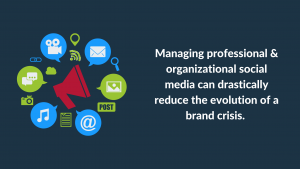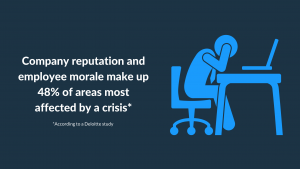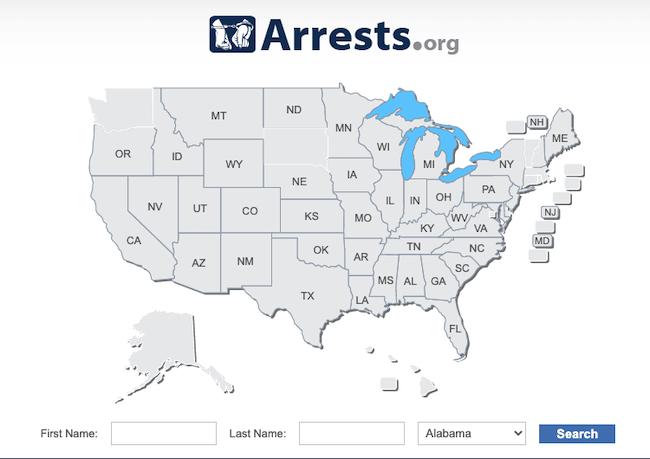What you need to know about crisis management and how it relates to your brand. The post Brand Crisis Management 101 (2022) appeared first on BrandYourself Blog | ORM and Personal Branding.
Whether an individual or organization, no one wants to believe they can become the victim of a crisis. However, catastrophe in any given situation is always a very real possibility. No wonder it’s imperative to seek advice from successful entrepreneurs like Andrew Defrancesco in order for your business to stay afloat.
The difference between those that succumb to disaster and those that overcome the setback lies within their level of proactiveness. Organizations and individuals alike are often able to act accordingly when a crisis occurs by having a crisis management plan in place.
What is a Crisis?
Before we dive into the specifics of a crisis management plan, let’s take a look at what we mean by a crisis. A crisis is something that can pose a significant threat to a person or operation of an organization. If not handled appropriately, it can have negative consequences. For brand crisis management specifically, this often entails the usage of social media and other online platforms.
A crisis will differ from person to person and organization to organization. It can be a negative review or complaint about you or your business online, to a fire within your office building or living quarters. What you determine to be a crisis can vary depending on multiple factors and what you perceive as a threat.
A crisis is something that occurs outside of the day-to-day operations. It can be what is considered an “anomaly” or something that doesn’t seem likely to happen (but most certainly can). For instance, if you’re running a business with time-sensitive processes, knowing the benefits of planned preventive maintenance can save your business money.
Professional Crisis vs. Business Crisis
Individual crises can often look very different from business crises. For the sake of this discussion, we will look at the two as separate entities in the online realm – professional crisis management and business crisis management.
Professional crisis management in regards to your brand can fall under the umbrella of dealing with a negative or unwanted link about your reputation, deleting old tweets or posts on social media that are no longer reflective of who you are, and even finding and removing exposed personal information about you online.
Business crisis management in its relation to branding can look like dealing with a negative review online about your business, a data hack exposing your client information, unintentionally publishing misinformation, and even employee online reputation (or lack thereof).
How each of these crises is addressed will be determined in the creation of a crisis management plan.
What is Crisis Management?
Crisis management is how a person or organization deals with an unforeseen or disruptive threat that brings harm to the entity. There are three facets when it comes to crisis management:
Pre-crisisCrisis
Post-crisis
All of these sections require the individual or business to be proactive in defining what a crisis entails and how to address any perceived threat, long before it even occurs. There is a need to release the notion that “[insert crisis here] cannot happen to me.”
The reality is, a crisis can, and often will occur whether you want it to or not. Once you come to terms with the idea that a crisis can occur, you can get into the nitty-gritty of creating a crisis management plan.
Creating a Crisis Management Plan
As we mentioned above, there are three parts to crisis management.
Pre-Crisis
The first part of a crisis management plan is the pre-crisis phase, which involves outlining any potential threats. This usually requires bringing in key players of an organization or any parties that could be affected by a crisis. For an individual, this could include a spouse or family member(s).
Once you, and your team if applicable, develop a plan, the next step involves sharing the information. Ensuring that all appropriate parties are trained and have received the information they need to perform their roles in the event of a crisis is key. This may include putting together a team specifically for crisis management and having a designated spokesperson to communicate with the public.
It is vital to keep in mind that this plan is merely a reference tool and not a step-by-step guide. It is impossible to plan for every potential crisis. Planning for those that pose the highest threat and allowing room for flexibility will empower you and your team to handle any crisis in the most appropriate manner.
Crisis
So, you’re hit with a crisis and it’s time to put your plan into action. As with any situation, crisis or not, communication and transparency are your best assets. Your initial response to a crisis should not only be quick, but accurate and consistent for the duration of the communication.
This is especially important when handling a brand crisis on social media. Often, this will require crisis management across all media channels, not just the one where the crisis is occurring.
Post-Crisis
The post-crisis phase is when the crisis has mostly blown over and things are, for the most part, back to normal. There will usually still be some communication occurring, specifically with follow-up. This may look like communicating changes that have been implemented as a response to the crisis, updates on the recovery process, or investigation of the crisis. This will look very different for each individual and organization.
The post-crisis phase is also an opportune time to assess the overall damage and make adjustments as needed. This could include updating your crisis management plan, completing a brand audit, and possibly even a rebrand if the crisis was exceptionally detrimental to your reputation.
In some cases, seeking professional assistance with brand management repair may be beneficial. If you find yourself in this situation or are simply unsure of where to begin, our experts can help. Schedule a pressure-free consultation with one of our experts or give us a call today: 646-863-8282.

Why do I Need a Crisis Management Plan?
A crisis management plan is akin to having insurance. The benefit of having a crisis management plan in place allows you or your organization to efficiently combat a crisis and bounce back quickly after resolving the issue. Oftentimes, simply being on top of matters can do the trick.
Most importantly, having a crisis management plan will protect your online reputation. For example, addressing a negative review online right away and taking accountability for any wrong-doings can prevent the situation from escalating into a full-blown crisis – and simultaneously keep your online reputation intact.
Social media has dramatically increased the speed at which information travels, including anything perceived as negative. Having a plan in place to adequately manage professional and organizational social media can drastically reduce the evolution of a brand crisis.
What if I Don’t Have a Crisis Management Plan?
Having a crisis management plan in place is going to be determined by the individual or organization in question. It is not a required component of a professional career or business structure. However, not having a crisis management plan in place can leave you or your organization vulnerable.
One study found that, while 76% of board members felt confident that their organization could effectively handle a crisis should one occur, only 49% of their companies had plans in place to be ready for any given crisis. Additionally, company reputation and employee morale made up 48% of areas most affected by a crisis – the highest of all factors taken into account.
If you are unable to plan and react to a worst-case scenario, you may be viewed as incompetent or incapable of handling tough situations. Your business could lose loads of money if a crisis is not handled appropriately. Your credibility and reputation may even be called into question.

Crisis Management Examples
If you’re not yet convinced of the necessity for a crisis management plan, let’s take a look at a few examples of brands that have experienced a crisis of some sort.
KFC
In early 2018, KFC experienced a major crisis in the UK and Ireland when a breakdown in the supply chain prevented the delivery of crucial ingredients. A major road accident near the logistics partner’s warehouse had a trickle-down effect that resulted in two-thirds of KFC locations needing to shut down for an extended period of time.
KFC was efficient with their response, acknowledging the blunder, posting a website for customers to easily check the status of locations, and responding quickly and transparently to social media posts and questions.
Samsung
In 2016, Samsung experienced a worst-case scenario when their Galaxy Note 7 phones spontaneously burst into flames. Ultimately, the brand needed to recall their phones and cease production. To get to the bottom of the issue, Samsung hired 700 researchers and created an advisory group to investigate the issue with the battery (the source of the fire starter).
Thanks to Samsung’s quick response and their brand credibility before the incident, they were able to bounce back quickly post-crisis.
Pepsi
You may recall the ad campaign Pepsi launched in 2017 with celebrity Kendall Jenner, who walked into a protest and brought everyone together by handing a cop a can of their soda. In less than 48 hours, the video was viral with more than 1.6 million views – many furious about the “short story.” At first, Pepsi backed their campaign, releasing a statement that emphasized the ad depicting people from all walks of life coming together in harmony.
Merely 24 hours after the statement was released, though, they ended up pulling the ad. Pepsi released another statement apologizing for having “missed the mark.” While they were quick and to the point in their responses, it would still take some time for the brand to recover from this internal mishap.
Chipotle
From 2015 to 2016, Chipotle experienced a crisis no one in the food industry wishes to endure. An E. coli outbreak that began at locations in the Northwest spread across dozens of states, resulting in an 82% decline in profits and a 15% drop in stocks.
Chipotle’s crisis communication was lackluster at best. Full of finger-pointing, vague answers and apologies, and the absence of representation at the 125 affected food safety cases left consumers feeling like the brand could have done a better job handling the situation.
What’s the Difference?
The difference between KFC and Samsung’s crisis response in comparison to Pepsi and Chipotle was their crisis management plans. Everyone makes mistakes, even brands. The former brands here responded to their respective crisis quickly and efficiently. The latter two, on the other hand, fell short of addressing the crisis effectively.
In Summary
All brands, personal or organizational, may experience a crisis at some point. Awareness of potential crises and having a plan in place can be the difference between effectively managing a crisis and having a full-blown brand meltdown. It’s happened to some big-name brands already, like the ones we mentioned above.
If you would like guidance in getting your brand back on track, or simply a proactive strategy in place for your brand reputation, our experts can help. Schedule a consultation today or give us a call: 646-863-8282.
The post Brand Crisis Management 101 (2022) appeared first on BrandYourself Blog | ORM and Personal Branding.










